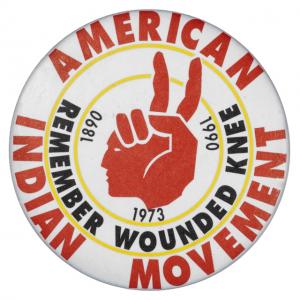 "The choice now lies with the leaders of the American government--to use violence upon us as before to remove us from our Great Spirit's land, or to institute a real change in its dealing with the American Indian. We do not fear your threat to charge us with crimes on our land. We and all other oppressed peoples would welcome spectacle of proof before the world of your title by genocide. Nevertheless, we seek peace."
"The choice now lies with the leaders of the American government--to use violence upon us as before to remove us from our Great Spirit's land, or to institute a real change in its dealing with the American Indian. We do not fear your threat to charge us with crimes on our land. We and all other oppressed peoples would welcome spectacle of proof before the world of your title by genocide. Nevertheless, we seek peace."
Richard Oakes at the occupation of Alcatraz, 1969
The American Indian Movement was a response to continued government assimilation and relocation policies. Created by an organization of Minnesota's Native American people in 1968, the group asserted Native rights by calling national attention to racism and land rights through protests, occupations (like those at the former federal prison on Alcatraz Island in San Francisco Bay, and at Wounded Knee, site of an infamous massacre of Indians in 1890), government negotiations, and the revival of language and cultural practices. Survival schools, such as the Red School House in Minneapolis, were opened to educate and advocate for Indian children.
Watch Taking AIM: The Origins of the American Indian Movement
American Indian Movement: Grand Governing Council.
Kenney, Dave, Hillary Wackman, and Nancy O'Brien Wagner. Northern Lights: The Stories of Minnesota's past. St. Paul, MN: Minnesota Historical Society, 2013.
Warrior, Robert and Smith, Paul Chaat. Like a Hurricane: The Indian Movement from Alcatraz to Wounded Knee. New Press, 1996
Websites
American Indian Movement: Grand Governing Council.
American Indian Movement, Plymouth Ave., N. Minneapolis, Minnesota. Placeography. Minnesota Historical Society.
Taking AIM: The Origins of the American Indian Movement.
Secondary
Kenney, Dave, Hillary Wackman, and Nancy O'Brien Wagner. Northern Lights: The Stories of Minnesota's past. St. Paul, MN: Minnesota Historical Society, 2013.
Sites




